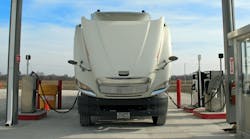While governmental regulations, overseen by the U.S. Environmental Protection Agency (EPA), continue to focus on reducing vehicle emissions, there are a number of terms that require definition in order to understand the full scope of how the requirements impact vehicle performance and efficiency as it relates to the powertrain.
During the diesel engine combustion process, a number of byproducts that can cause adverse health effects are created. These byproducts include nitrogen oxide (NOx), carbon monoxide (CO), and particulate matter (PM). Hydrocarbons are also a byproduct, as part of the leftover fuel that is not used during the combustion process.
The heavy duty diesel engine aftertreatment system is designed to limit the amount of exposure of these pollutants. There are two primary systems to help capture these emissions before they’re emitted into the atmosphere: the exhaust aftertreatment technology — which includes the diesel oxidation catalyst (DOC) and diesel particulate filter (DPF) — to capture particulate matter; as well as a selective catalytic reduction (SCR) system, and an exhaust gas recirculation (EGR) system, to help reduce NOx emissions.
“High black smoke [particulate matter] can put a bigger burden on the diesel particulate filter. Similarly, high NOx can put a bigger burden on the SCR system,” says Kris Ptasznik, X15 product manager, Cummins.
“Engines equipped with an EGR [system] to control NOx require higher injection pressures for better mixing,” Ptasznik adds. “Reduced NOx enables [the] engine and [the aftertreatment] system to reduce fuel and urea consumption.”
Here’s a review of the most common components and terms:
- Diesel particulate filter (DPF) system – This system is designed to capture the particulate matter (PM) generated from the combustion process.
- Diesel oxidation catalyst (DOC) – This part of the aftertreatment system oxidizes carbon monoxide and hydrocarbons in order to limit emissions.
- Nitrogen oxide (NOx) – The SCR system is designed to capture NOx before it leaves the vehicle system and enters the atmosphere. The SCR system uses diesel exhaust fluid (DEF), also known as urea, to create a chemical reaction that breaks down the NOx.
- Carbon monoxide (CO) – The residual material left during the combustion process of diesel fuel or gasoline. It is a byproduct of incomplete combustion of the fuel and can be damaging to the environment.
- Particulate matter (PM) – Particulate matter, which includes dirt, dust, and soot, is the byproduct material created by the engine after the fuel combustion process. With present-day aftertreatment systems, the DPF is designed to capture PM. The DPF should be periodically cleaned on the vehicle, through a regeneration process, as well as replaced and/or removed to be more thoroughly cleaned, at regular intervals, to ensure continued collection of PM.
- Ash – Ash is the leftover residue remaining in the DPF after PM, or soot, is captured. This is the material that accumulates in the DPF media.



